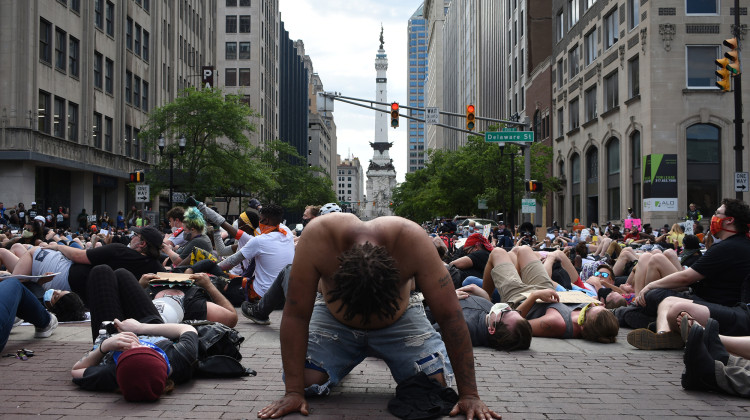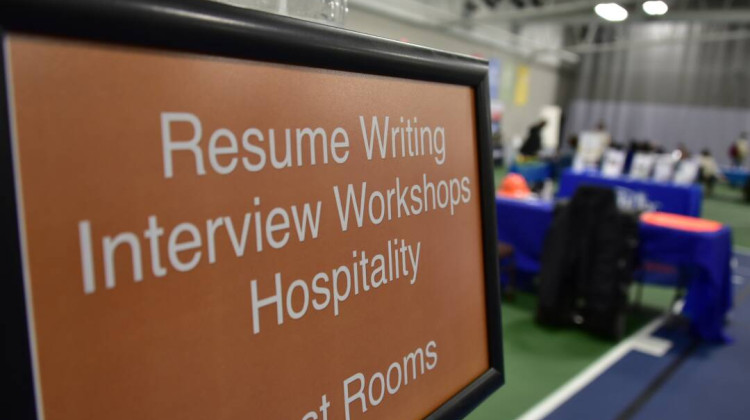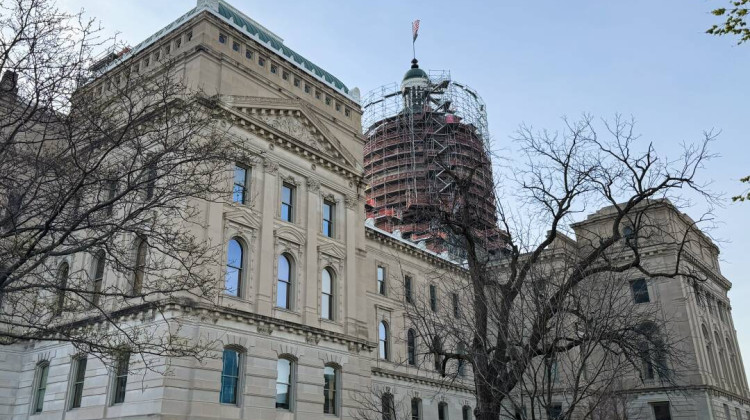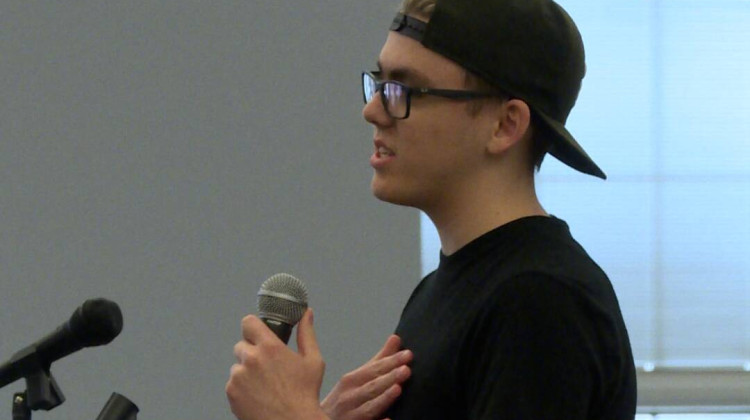
Protesters in downtown Indianapolis stage a "die in" to draw attention to police brutality during the 2020 Black Lives Matter protests.
FILE PHOTO: Justin Hicks / IPB NewsOver the past decade, the U.S. has seen several large protest movements — advocating against things like racial injustice, sexism, gun violence, climate change and even vaccinations. While some legislation came out of these movements, all of these issues are still hot topics today. That begs the question — what makes an effective protest?
Danielle Brown is an associate professor at Michigan State University and researches social media and journalism. She said while protests may look a little different in the age of social media, organizers still face a lot of the same struggles they did during past uprisings — like the Civil Rights Movement in the 1950s and '60s.
“The challenges are very similar in terms of getting people to stop what they're doing on a regular day and care about an issue. Getting people to go out and literally sort of give up their day-to-day every day and stand in the street or attend a sit-in or engage in some sort of not-for-pay advocacy that they believe in,” Brown said.
Indiana Public Broadcasting spoke with Brown about what makes an effective protest. Here are the takeaways from our conversation.
Connect with like-minded people
Brown said the first step is to find a community of people who want to see change just like you do.
“That sort of collection of minds and ideas is what helps you be able to communicate the grievance to a larger audience, but also to figure out really creative solutions like, well, if something's wrong — the next question is what are you going to do about it? And the answer may be protest,” she said.
It also helps to put your heads together to figure out what would solve the problem.
“If you are wanting more water quality testing or something like that, what is the solution? How are you going to — who do you need to ask for that? How are you going to ask for that?” Brown said.
She suggests looking for organizations already engaged in the issue or similar issues — whether that’s an established nonprofit or a club at your local library. If you can’t find such a group, consider writing a letter to the editor of your local newspaper and checking the comments for other people who agree. You can also look through the comments if there are articles about that particular issue as well.
Have a clear, unified message and concrete solutions
Brown said social media has made organizing a protest faster and able to reach more people. Before the internet, you might only hear about a protest by word of mouth or letter writing campaigns. But social media brings its own challenges.
“The more people you have, the more brains and minds and opinions you have — which can make it challenging to have a concrete and very direct message,” Brown said.
This is especially true if some of the people involved in the protest agree with the basic principles behind it, but maybe aren’t as informed about what change organizers want to see.
Take the Women’s March protests in 2017, which happened the day after Donald Trump was inaugurated as president. Hats made for the event referenced an obscene recording that was released where Trump talked about his attitudes toward women.
“You might think that all of the Women's March movements are simply about Trump, right? And they aren't. They're about the advancement of women's rights and their protection in the United States and beyond,” Brown said.
Brown said too many voices can also lead to oversimplification. The 2020 demands of the Black Lives Matter movement were largely distilled by the press and others to “defund the police.” In South Bend, for example, those demands were more specific. They included accountability for the police killing of Eric Logan and a halt to proposed pay increases for city police.
“Because not everyone was on the same page about what the actual solutions should be and how to present those solutions,” Brown said.
Be strategic about timing
Brown said, unfortunately, protests are more likely to change people’s hearts and minds when timed after a tragic event.
“The circumstances in which we understand George Floyd were amazing in the sense that we wouldn't have gotten them without a bystander providing us with footage. But racial injustice and these sorts of acts happen every day, unseen,” Brown said.
She said tragedies like these are an opportunity to speak to other people about their humanity and the loss of humanity for others. This is even true of harms that don’t seem as tangible — like climate change.
“So the slow burn of climate change is happening all the time. But when we have, you know, unprecedented flooding across North Carolina and Tennessee, that's when we really have as a social movement the most strategic opportunity to pounce — to help people understand this is what we're talking about,” Brown said.
Join the conversation and sign up for the Indiana Two-Way. Text "Indiana" to 765-275-1120. Your comments and questions in response to our weekly text help us find the answers you need on statewide issues, including our project Civically, Indiana.
Be disruptive
A protest that prevents politicians or everyday citizens from going about their day-to-day lives can help bring attention to an issue, said Brown.
“It's having protests in spaces where you don't have a permit yet. It's stopping highways so that other people will learn that or understand that it's time to pay attention. Right? It is what people refer to as lawlessness in some cases," she said. "But the reason that protesters engage in that is because saying ‘I want justice for a particular issue’ isn't enough. Because many protests start with ‘We've brought this to our legislators attention. We've said this to our senators before. No one is hearing us.’”
Brown said people don’t always take disruption well, however.
Make connections with journalists
Brown said media coverage is critical for the public to understand what protesters are doing and shape public opinion. She said organizers need to understand what reporters find newsworthy — especially how to bring new conversations to ongoing issues like racial justice and climate change.
Journalists could do a better job of covering protests too. Brown said at first, they’re more likely to focus on the disruptive tactic that protesters are engaging in — like blocking a highway — rather than why they’re protesting.
“Then over time, they start incorporating what that protest was about as a headliner for news. And so I think that the quicker journalists can understand what protests are truly about and find ways to headline them up front — alongside some of these actions that are breaking news in many ways — the better they'll be able to inform publics,” she said.
Brown said protesters have to strike a delicate balance between using disruptive tactics to get the media’s attention, but also reminding journalists why they’re protesting and what change they want to see.
Realize change takes time
“We don't actually see very often where something happens and a protest is responded to and then a policy change is made,” Brown said.
Often, she said, protests inch toward that change — by bringing more people and groups into the movement or getting funding.
Brown said quick changes aren’t the norm and sometimes get quickly reversed. For example, she said some news organizations vowed to change the way they report on protests led by racial minorities after the murder of George Floyd and added several new reporter positions. Brown said many of those positions weren’t sustainable and now no longer exist.
“It's slow change that is the norm because it requires not just like a legal shift, it also requires a societal and a cultural shift and acknowledgment of what is shifting to be able to make it be able to sustain over time,” Brown said.
Rebecca is our energy and environment reporter. Contact her at rthiele@iu.edu or follow her on Twitter at @beckythiele.
 DONATE
DONATE






 Support WFYI. We can't do it without you.
Support WFYI. We can't do it without you.